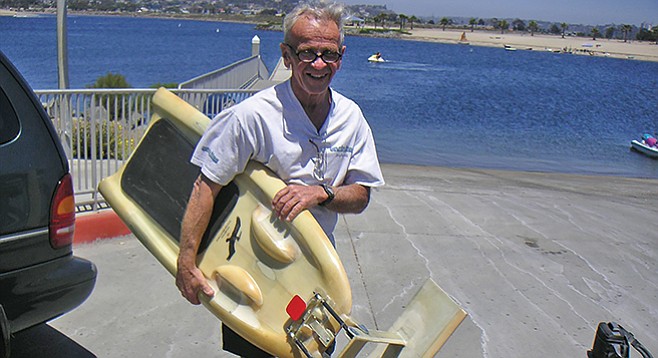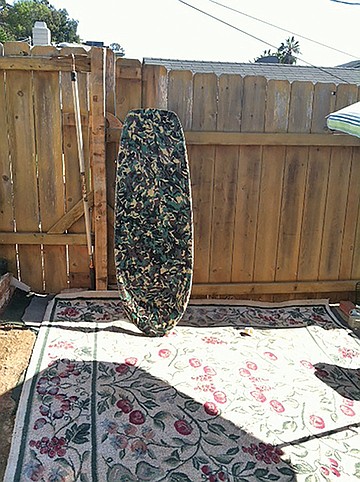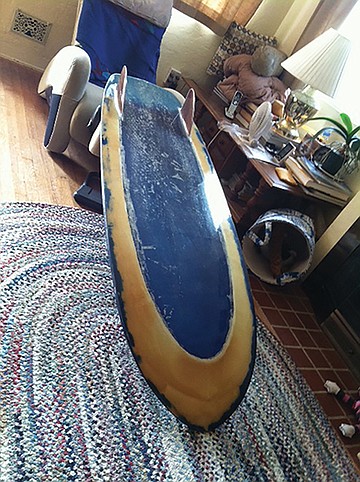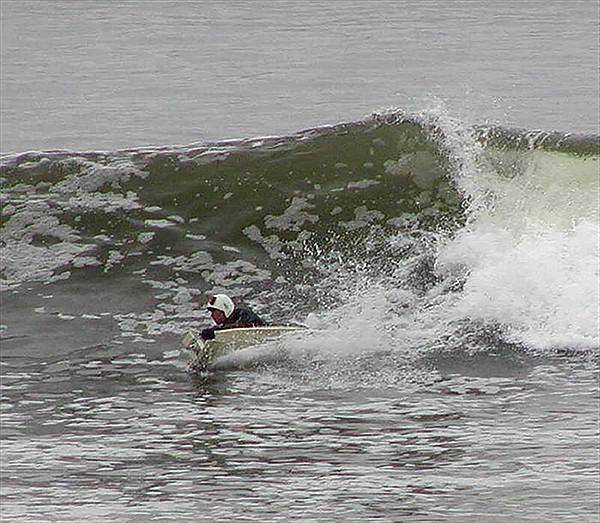 Facebook
Facebook
 X
X
 Instagram
Instagram
 TikTok
TikTok
 Youtube
Youtube

I first met Terry Hendricks showering off by the lifeguard tower after a morning surf in Ocean Beach around 1970 or ’71. At the time I was unaware he was a noted scientist and held a doctorate in physics. He was just a surfer with the most unique surfboard I’d ever seen. He was a kneeboarder, and at that time kneeboarders were the most progressive surfers around. They rode the shortest boards and consistently got into more radical places on waves than anyone ever had.


Terry’s board was a flexible “spoon,” a board with a full hull design constructed so that it will bend and absorb and release the wave’s energy as it is being ridden, which was a trip for sure, but the thing that blew my mind was its construction. Most spoons have foam rails on the sides with several layers of fiberglass in between. The shape of the foam rails determines how the board bends under the influence of the wave you are riding. Terry’s board was the same but instead of foam in the rails they were hollow. So he had this light-blue transparent glass board. With the sunlight shining through, it was like a piece of blown-glass art. So I had to talk to him to learn how he made it.
In that era, the shortboard revolution was in full swing. If you didn’t design, build, and ride your own boards you were, let’s say, less than cool. As Terry started to explain his theory and process for the board, I suddenly realized I had no idea what he was talking about. I picked up on a few bits but was mostly lost between hydrodynamics and technical properties of surfboard materials and his construction techniques. So I said, “Right on, bro. It’s a cool-looking stick. See you around,” and I went across the street to my job fixing dings. Several years later our paths crossed again.
My friend Stanley was invited by Terry Hendricks to go surf the Ranch (a pretty much off-limits section of coast north of Santa Barbara) and he could bring a friend. So, of course Stanley invited the best surfer he knew. He invited Zigz to go. I wanted to go but really Zigz was a way better surfer than I was. Also, the Ranch in the winter is mostly rights and I am a goofy-footer. Backside on fast powerful waves was way more difficult in the single-fin era. Well, it turned out Zigz couldn’t go, so I squeaked into the trip. Stoked, or what?
November 1977. I surf 8- to 12-foot Ranch with two top board designer/innovators, Stan and Terry. Terry’s boards were stranger than ever — flexible, floating island, kneeboards completely unique. So strange I didn’t know what to think. Stan’s board was more conventional, and I was riding an 8-foot gun with a single fin I had modeled after a thresher shark dorsal fin under Stan’s direction. Being the gunman on the trip, I figured I’d be catching the biggest and deepest waves.

The waves were big and the offshore wind was very strong. As we paddled for waves we were blind from the spray until halfway down the face. As I was stroking into one, in the corner of my eye I saw Terry already in and driving from 20 yards deeper and definitely going Mach 90. He burned by me so fast it was inconceivable. I saw Stanley get air off the top on a bigger set wave — doing it years before the mainstream caught up. It was a memorable trip. Those guys were ripping on truly advanced boards.
I continued surfing and working in the surfboard business. I started out sweeping floors and years later ran a surfboard factory on Oahu. I’m mostly a hobbyist now, building boards that interest me in some way. A while back I was visiting my friend Mark. In his backyard he had this old spoon layup. I asked him about it and he said that Terry had laid it up in one of his molds with him. He had wanted to finish it but had some setbacks due to poor construction techniques. He asked if I could save it, but as I surveyed it I thought it a lost cause. But to make Mark feel better I took it home and put it in the backyard. It sat for a couple years.
Every time I saw the board I’d think it looked cool but there was a lot wrong with it. Mark had used the wrong kind of resin and it was in a very crude state. One day, after sanding some dings on my board I ran the sander over the spoon. Then I peeled off two layers of glass to get down to the layers that Terry had done. I got down to where I thought I could make something happen with the board. Then it sat for another year while I mulled it over. I had a set of glass-on keel fins made of tiger wood from an old board. Tiger wood is light with a nice grain but has a lot of oils that come out from the heat generated while glassing them. This shows up as bubbles in the glass and looks bad. So I stripped them down and re-glassed them to use them on the spoon. I finally came up with a plan that I believed would make the spoon work. I applied three layers of glass with epoxy resin. I glassed on the fins, hot coated, and sanded the board.
During this time, news spread that Terry had passed away (June 13, 2013). I got all these ideas of making it a tribute board with artwork depicting Terry. So Mark and I thought about that for a while and even worked out some design ideas. But in the end we said screw it. It’s a surfboard, it’s for surfing. I applied a soft foam layer over the deck for comfort and to add flotation and left the bottom as it was, not pretty but fully functional. I gave Mark a paint pen and he wrote “In memory of Terry Hendricks” on the bottom and we went surfing. We came home smiling.


I first met Terry Hendricks showering off by the lifeguard tower after a morning surf in Ocean Beach around 1970 or ’71. At the time I was unaware he was a noted scientist and held a doctorate in physics. He was just a surfer with the most unique surfboard I’d ever seen. He was a kneeboarder, and at that time kneeboarders were the most progressive surfers around. They rode the shortest boards and consistently got into more radical places on waves than anyone ever had.


Terry’s board was a flexible “spoon,” a board with a full hull design constructed so that it will bend and absorb and release the wave’s energy as it is being ridden, which was a trip for sure, but the thing that blew my mind was its construction. Most spoons have foam rails on the sides with several layers of fiberglass in between. The shape of the foam rails determines how the board bends under the influence of the wave you are riding. Terry’s board was the same but instead of foam in the rails they were hollow. So he had this light-blue transparent glass board. With the sunlight shining through, it was like a piece of blown-glass art. So I had to talk to him to learn how he made it.
In that era, the shortboard revolution was in full swing. If you didn’t design, build, and ride your own boards you were, let’s say, less than cool. As Terry started to explain his theory and process for the board, I suddenly realized I had no idea what he was talking about. I picked up on a few bits but was mostly lost between hydrodynamics and technical properties of surfboard materials and his construction techniques. So I said, “Right on, bro. It’s a cool-looking stick. See you around,” and I went across the street to my job fixing dings. Several years later our paths crossed again.
My friend Stanley was invited by Terry Hendricks to go surf the Ranch (a pretty much off-limits section of coast north of Santa Barbara) and he could bring a friend. So, of course Stanley invited the best surfer he knew. He invited Zigz to go. I wanted to go but really Zigz was a way better surfer than I was. Also, the Ranch in the winter is mostly rights and I am a goofy-footer. Backside on fast powerful waves was way more difficult in the single-fin era. Well, it turned out Zigz couldn’t go, so I squeaked into the trip. Stoked, or what?
November 1977. I surf 8- to 12-foot Ranch with two top board designer/innovators, Stan and Terry. Terry’s boards were stranger than ever — flexible, floating island, kneeboards completely unique. So strange I didn’t know what to think. Stan’s board was more conventional, and I was riding an 8-foot gun with a single fin I had modeled after a thresher shark dorsal fin under Stan’s direction. Being the gunman on the trip, I figured I’d be catching the biggest and deepest waves.

The waves were big and the offshore wind was very strong. As we paddled for waves we were blind from the spray until halfway down the face. As I was stroking into one, in the corner of my eye I saw Terry already in and driving from 20 yards deeper and definitely going Mach 90. He burned by me so fast it was inconceivable. I saw Stanley get air off the top on a bigger set wave — doing it years before the mainstream caught up. It was a memorable trip. Those guys were ripping on truly advanced boards.
I continued surfing and working in the surfboard business. I started out sweeping floors and years later ran a surfboard factory on Oahu. I’m mostly a hobbyist now, building boards that interest me in some way. A while back I was visiting my friend Mark. In his backyard he had this old spoon layup. I asked him about it and he said that Terry had laid it up in one of his molds with him. He had wanted to finish it but had some setbacks due to poor construction techniques. He asked if I could save it, but as I surveyed it I thought it a lost cause. But to make Mark feel better I took it home and put it in the backyard. It sat for a couple years.
Every time I saw the board I’d think it looked cool but there was a lot wrong with it. Mark had used the wrong kind of resin and it was in a very crude state. One day, after sanding some dings on my board I ran the sander over the spoon. Then I peeled off two layers of glass to get down to the layers that Terry had done. I got down to where I thought I could make something happen with the board. Then it sat for another year while I mulled it over. I had a set of glass-on keel fins made of tiger wood from an old board. Tiger wood is light with a nice grain but has a lot of oils that come out from the heat generated while glassing them. This shows up as bubbles in the glass and looks bad. So I stripped them down and re-glassed them to use them on the spoon. I finally came up with a plan that I believed would make the spoon work. I applied three layers of glass with epoxy resin. I glassed on the fins, hot coated, and sanded the board.
During this time, news spread that Terry had passed away (June 13, 2013). I got all these ideas of making it a tribute board with artwork depicting Terry. So Mark and I thought about that for a while and even worked out some design ideas. But in the end we said screw it. It’s a surfboard, it’s for surfing. I applied a soft foam layer over the deck for comfort and to add flotation and left the bottom as it was, not pretty but fully functional. I gave Mark a paint pen and he wrote “In memory of Terry Hendricks” on the bottom and we went surfing. We came home smiling.
Comments